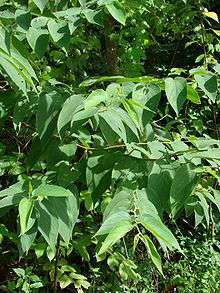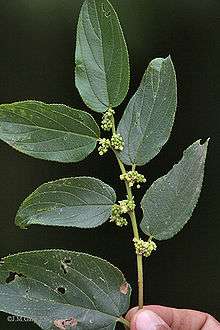Trema orientalis
| Trema orientalis | |
|---|---|
 | |
| Scientific classification | |
| Kingdom: | Plantae |
| (unranked): | Angiosperms |
| (unranked): | Eudicots |
| (unranked): | Rosids |
| Order: | Rosales |
| Family: | Cannabaceae |
| Genus: | Trema |
| Species: | T. orientalis |
| Binomial name | |
| Trema orientalis (L.) Blume[1] | |
| Synonyms[2][3][4] | |
| |
Trema orientalis is a species of flowering tree in the hemp family, Cannabaceae. It is known by many common names, including charcoal-tree,[4] Indian charcoal-tree,[4] pigeon wood,[5] Oriental trema,[6] and in Hawaii, where it has become naturalized gunpowder tree,[7] or nalita.[8] It has a near universal distribution in tropical and warm temperate parts of the Old World, with a range extending from South Africa, through the Middle East, the Indian subcontinent and southern China to Southeast Asia and Australia.
Native distribution
Trema orientalis is native to primarily tropical zones in Africa (in Benin; Cameroon; Central African Republic; Comoros; Côte d'Ivoire; the Democratic Republic of the Congo; Equatorial Guinea (including the island of Bioko); Eritrea; Ethiopia; Gabon; the Gambia; Ghana; Guinea; Guinea-Bissau; Kenya; Liberia; Madagascar; Malawi; Mozambique; Namibia; Rwanda; Senegal; Sierra Leone; Somalia; South Africa (Cape Province, KwaZulu-Natal, Transvaal; and Swaziland); Sudan; Tanzania (including the Zanzibar Archipelago); Togo; Uganda; Zambia; and Zimbabwe); Asia (in most of the Arabian Peninsula; Bhutan; Burma; China, in the provinces of Fujian, southern Guangdong, western Guangxi, southwestern Guizhou, Hainan, Sichuan, Xizang, Yunnan; India; Indonesia; southern Japan in Kyushu prefecture and the Ryukyu Islands; Malaysia; Nepal; Papua New Guinea; the Philippines; Sri Lanka; Taiwan; Thailand; and Vietnam); and Australia (in the northern portion of Northern Territory and eastern parts of Queensland).[4]
General use
The wood is relatively soft, and burns easily and quickly when dry. The wood is suitable for paper and pulp production,[9][10] producing paper with good tensile strength and folding endurance.[9] The bark can be used for making string or rope, and used as waterproofing fishing-lines.[5][11] In India and Tanzania, the wood is used to make charcoal.[11]
Medicinal use
The tree has various uses as an herbal medicine in a wide range of cultures.[5] The leaves and the bark are used to treat coughs, sore throats, asthma, bronchitis, gonorrhea, yellow fever, toothache, and as an antidote to general poisoning[9][12] A bark infusion is reportedly drunk to control dysentery and a leaf decoction is used to deworm dogs.[9] In recent pharmacological studies, an aqueous extract from the bark has been shown to reduce blood sugar levels in an experimental animal model of diabetes mellitus, and may be useful for treating this disease.[13] Extracts from leaves of related species (Trema guineense and Trema micrantha) showed anti-inflammatory, anti-arthritic and analgesic activity in rodents,[14] suggesting that T. orientalis could produce similar results.
Ecological significance
This species has a high ecological impact with at least 14 species of butterfly using it as a larval food plant.[5] Several species of birds eat the fruit or feed on the abundant insects which live in these trees. Pigeons and doves are often found in these trees where they eat the fruits or make their nests; giving the origin of the name 'Pigeon Wood'.[5] The leaves, pods and seeds are used as fodder for cattle, buffaloes and goats in the Philippines.[9][12] The leaves are also browsed by game animals and can be used as spinach. This tree is a fast-growing species found in previously disturbed areas and on forest margins. It is a pioneer species that can grow on poor soil and can be used to regenerate forest areas by providing shade and protection to saplings of forest hardwoods. T. orientalis is nitrogen fixing and can thereby improve soil fertility for other plant species.[12]
Gallery
 Flowers and leaves
Flowers and leaves- Ripe fruit and bark of Trema orientalis
- Green and ripe (black) fruit
- Branch bent down to show leaves and fruit
References
- ↑ Under its treatment of Trema orientalis (from its basionym of Celtis orientalis), this plant name was first published in Museum Botanicum 2: 62. 1852. "Name - Trema orientalis (L.) Blume". Tropicos. Saint Louis, Missouri: Missouri Botanical Garden. Retrieved November 2, 2011.
- ↑ "Name - !Trema orientalis (L.) Blume synonyms". Tropicos. Saint Louis, Missouri: Missouri Botanical Garden. Retrieved November 2, 2011.
- ↑ The basionym of T. orientalis, Celtis orientalis was originally described and published in Species Plantarum 2: 1044. 1753. "Name - Celtis orientalis L.". Tropicos. Saint Louis, Missouri: Missouri Botanical Garden. Retrieved November 2, 2011.
Type-Protologue: Locality: Habitat in Indiis: Distribution: Sri Lanka
- 1 2 3 4 GRIN (May 29, 2007). "Trema orientalis information from NPGS/GRIN". Taxonomy for Plants. National Germplasm Resources Laboratory, Beltsville, Maryland: USDA, ARS, National Genetic Resources Program. Retrieved November 2, 2011.
Comment: although treated [at GRIN] as feminine, in accordance with botanical tradition (Vienna ICBN Art. 62.1), the genus is of neuter gender according to NCU-3
- 1 2 3 4 5 Malan, Christien; Notten, Alice. Kirstenbosch National Botanical Garden. (April 2005). "Trema orientalis". South African National Biodiversity Institute. Retrieved 2 March 2010. Cite uses deprecated parameter
|coauthors=(help) - ↑ "Trema orientalis". Natural Resources Conservation Service PLANTS Database. USDA. Retrieved 14 December 2015.
- ↑ Little Jr., Elbert L.; Skolmen, Roger G. (1989). Common Forest Trees of Hawaii: Gunpowder-tree (PDF). Agriculture Handbook No. 679. USDA. Retrieved 2010-03-02.
- ↑ Jahan, M. Sarwar; Sung Phil Mun (April 2007). "Characteristics of Dioxane Lignins Isolated at Different Ages of Nalita Wood (Trema orientalis)". Journal of Wood Chemistry and Technology. 27 (2): 83–98. doi:10.1080/02773810701486865. Retrieved 2010-03-02.
- 1 2 3 4 5 Orwa, C; A Mutua; Kindt R; Jamnadass R; S Anthony (2009). "Trema orientalis". Agroforestree Database:a tree reference and selection guide, version 4.0. World Agroforestry Centre. Retrieved 2010-03-09. External link in
|work=(help) - ↑ Jahan, M.S. et al. (2007). Evaluation of cooking processes for Trema orientalis pulping Journal of Scientific & Industrial Research, Vol. 66 (2007) 853
- 1 2 FAO Forestry Department (1986). Some Medicinal Forest Plants Of Africa And Latin America Forestry - Paper 67 (PDF). pp. 223–227. Retrieved 2010-03-02.
- 1 2 3 Eckman, Karlyn; Hines, Deborah A. (1993). "Trema orientalis". Indigenous multipurpose trees of Tanzania: uses and economic benefits for people. FAO Forestry Department. Retrieved 2010-03-02.
- ↑ Dimo T, Ngueguim FT, Kamtchouing P, Dongo E, Tan PV (2006). "Glucose lowering efficacy of the aqueous stem bark extract of Trema orientalis (Linn) Blume in normal and streptozotocin diabetic rats". Die Pharmazie. 61 (3): 233–6. PMID 16599266.
- ↑ Barbera, R.; Trovato, A.; Rapisarda, A.; Ragusa, S. (1992). "Analgesic and antiinflammatory activity in acute and chronic conditions of Trema guineense (Schum. et Thonn.) Ficalho and Trema micrantha Blume extracts in rodents". Phytotherapy Research. 6 (3): 146. doi:10.1002/ptr.2650060309.
Bibliography
- Pooley, E. (1993). The Complete Field Guide to Trees of Natal, Zululand and Transkei. ISBN 0-620-17697-0.
External links
| Wikimedia Commons has media related to Trema orientalis. |